- Home
- Annie Proulx
Fine Just the Way It Is Page 11
Fine Just the Way It Is Read online
Page 11
“That was a good catch. Reckon your rope was old?”
“Hell, yes. Couple years I didn’t use it. They say ever year you don’t use a rope it loses half its strength. How about that old horse climb up that wall?”
Fenk was back with the Crosley after a wide hour and they loaded Hi into the backseat. There was no room for the Tolbert boys who rode back to the horse trap. Business was business.
All the way to Rock Springs Hi joked and laughed, said he had had a fine day, that he’d just as soon quit the coal mine before the strip machinery came in and go back to chasing horses with Fenk.
“Stop at the house first,” he said. “I’ll let Helen know I’m okay. Otherwise she’ll be up at the hospital devilin everbody.”
Helen came out on the porch as Fenk pulled up. She had the fearful-woman look on her face. She leaned in, staring at Fenk, not seeing Hi in the back.
“What’s wrong!” She knew it was bad if Fenk was alone. Her old dislike of her sister’s husband, who caused harm to all around him, rose, flared anew.
From the backseat Hi called out that he was fine, and she cried a little, saying they really had her going there for a minute.
“They’ll set the leg at the hospital and Fenk can bring me home. What’s for dinner?” He laughed.
At the emergency entrance of the hospital Fenk parked near the door and walked in. It took him ten minutes to find anyone. He came back with Doc Plumworth whose mouth was so small only two teeth showed when he smiled, the cross-eyed nurse and a gurney. Doc opened the back door of the Crosley and pulled at Hi’s arm.
“It’s okay, fella, we’ll get you fixed up,” he said in his crackery voice. He pulled again, turned to Fenk. “Thought you said he was in good spirits. Thought you said he was conscious.”
“Christ, he is. Horse kicked him in the leg, that’s all. I been kicked a hunderd times myself. Talked and laughed all the way in. Told jokes. Just stopped by his house to see his wife couple minutes ago.”
Doc Plumworth, half in the backseat, had been examining Hi.
“Well, he’s not telling jokes now. He’s dead. Horse kicked him? I’ll bet you…”
Helen heard Fenk’s Crosley outside again. That was pretty quick, she thought. The coffee was perking and she was reheating the lamb stew. She opened the door to Fenk. He stood there, working his mouth, glutinously whispered something like “clot,” then looked at her with his great staring eyes. Her mind snarled like a box of discarded fiddle strings. Civilization fell away and the primordial communication of tensed muscle, ragged breath, the heaving gullet and bent fingers spoke where language failed. She knew only what Fenk had not yet said and didn’t need to say.
And shut the door in his face.
Deep-Blood-Greasy-Bowl
During construction of our house the builders unearthed an ancient fire pit. Carbon 14 testing indicated an age of 2,500 years, centuries before the Indians had horses or bows and arrows. Other fire pits, nearby tipi rings, projectile points and a chert quarry attest to long Indian presence on the land. Facing the house is a limestone cliff where a bison drive over the edge may have occurred in ancient days. Imagining the time and the hunt made this small story.
Gradually the familiar sounds of night and sleep gave way. A few men came awake at once and raised up on their elbows, listening to the change. The chill air presaged autumn. In the blue draw coyotes argued. A sated owl on the island hooted and the river choked through sunbaked stones. But these were common sounds, and had not wakened the men. Silence disturbed their sleep, the cessation of a voice. The shaman had stopped chanting. Night after night the thready monotone of his prayers and invocations had formed the solemn background of the band’s dreaming. His beckoning, coaxing voice had become as elemental as chirring grasshopper wings or the rattle-stick cries of flying cranes. Forbidden to eat during the ceremonial invocation the old man had grown gaunt and his voice had wavered almost to inaudibility. But now he was quiet, task completed, and into the vacuum of silence rushed excitement.
The men who had immediately wakened—the hunters—strained for the aural vanishing point, those sounds too remote for all but the inner ear. The need to put on fat, to store food against the hungry winter slinking toward them made them exquisitely sensitive to nuances of the natural world: strong clouds rubbing against the sky like a finger drawn over skin, the quiver of a single blade of grass in calm air showing subterranean movement. Some could tell by the briny smell of seaweed when storms were advancing from the distant ocean. A few branches of cottonwood leaves had already turned an urgent yellow; the first frosts hung over them like veils of thin rain not yet touching the ground.
Below their suspirations and heartbeats, they sensed the roaring of bison deep inside the earth, a bellowing that made bedrock quiver and promised that something long-awaited was about to happen. The shaman’s silence allowed the promise to become a hot expectation of blood and meat, for bison, in their wandering journey through the world, were surely moving toward them.
The men rose and went outside to relieve themselves in the sagebrush, stared at the sky for its message. It was flat and colorless in the predawn as though rubbed by an antler polishing tool. It said nothing. It would be a hot, breathless day, affirming that summer still lay on them like a panting wolf on a red bone.
The hunters asked each other, How many? It was crucial to know how many.
It had been years since a herd had come within driving distance of the cliff, but because it had happened in the past at the end of one summer the band had continued to camp near the foot of the precipice, knowing it would happen again. The river lay between their camp and the pale limestone cliff. It was summer’s end and the hard sun had incinerated all rain clouds until the river barely skimmed the gravel bars. At the base of the cliffs a strip of brushy ground fronted steep talus slopes, the millennial accumulation of debris from crumbling rock. The last time the driven animals had plunged into the terrifyingly steep chimney, some finally rolling down the talus slope, others piling up on it, a mass of kick-leg flesh. The butcher women had rushed at them with their biface chert knives, skinning and slicing tools, pitched the offal into the gulping river.
From the tipi camp on the south side of the river every detail of the cliff face and the lives of the animals and birds who lived in and on it dominated their view. A small band of mountain sheep moved around the upper benches out of range, sometimes gazing haughtily down at them, sometimes still and bunched like pale fists. A pair of eagles and their two grown young played in the updrafts above the cliff, their thin, tumbling calls requests for prayers. As always, the young men made plans to capture them for their feathers, but they also begged the eagles to carry their wishes for a successful hunt to the spirits. There was a thrilling moment that sent chills down their spines when the eagles separated in the air and flew to the four sacred directions. Never had there been such a strong sign of the future.
In the spring one of the hunters, now a mature man but only a boy the last time the bison had allowed themselves to be driven over this cliff, had dreamed that this year they would come again. They would come through the east pass. They were coming, he knew it, a black mass pouring out of their deep hole into sunlight, stirring the powdery earth into dust clouds. He dreamed of spurting bright blood, slippery and strength-giving, coursing down the chins of his children, the yielding juiciness of fresh liver warm from a beast that moments before had been running out its life. He woke from the dream with the taste of liver and spicy gall in his mouth. The shaman also remembered that earlier hunt and said the man’s dream was a true dream.
The intensity of the hunter’s memory of the kill many seasons earlier had commanded attention from the others. Their tipi skins were old and patched, and so, in early summer they made the journey to that jump-off place. There were other reasons than bison to come here; innumerable sego lilies grew in a certain draw where in spring the women dug the bulbs with antler points; goosefoot and biscuit-root grew nearby.
There was ricegrass around the sand dunes, fish, beaver and mink in the river, pronghorn and deer feeding along the waterway and the mountain sheep on the cliff. Countless birds and thousands of small animals lived in this rich riparian habitat.
On the great downslope atop the cliff the men and boys strengthened the old drive lines of stones with additional rocks, white lumps of limestone that showed even in twilight. Beside the western cairn marking the edge, the hunters dug a hiding pit for the shaman, who would pull the bison forward by incantation and the luring sound of his flute. When they finished, the heaps of stones extended out in lines from the top of the cliff toward the distant pass. The bison would come from that direction. It was the only possible direction. Near the top of the cliff a brushy draw, the upper end of the sego lily slope, angled toward the point where the drive line hooked inward to compress the herd. As the animals moved up the grade toward the drop-off, the flanking drivers would rise from hollows in the ground, from concealing sagebrush, and press them into panic. If the herd began to veer toward the shelter of the draw, the boys and young men concealed in that earth crease would rise up ululating and turn them irrevocably toward the edge. It was dangerous and beautiful, this death run with the bison. That was how it had been done in the earlier time. That was how they would do it again. It was what they had been born for.
Some men went to the chert vein that erupted along a ridge beyond the sand dunes, worrying the desirable nodules coated with white calcareous cortex from the earth. They would carry as many as they could back to the camp, bury them in the earth and build a fire on top for the slow heat treatment that made chert glossy and easy to work. Later, from the tempered chert they could strike good cores for making scrapers, projectiles and knife blades.
The hunter who had been a boy at the time of the previous hunt spoke again, as he had many times, of the sand dunes near the base of the great slope where the drivers had to work with the wind, not letting themselves be seen but guiding the keen-nostriled beasts between the drive lines by the presence of alien human odor. The others had heard all this and seen the terrain each fruitless year when no bison came or only a too-small group that could not be driven. The hunter once more told them how the stampeders lying hidden behind sagebrush, badger tumuli and prairie dog mounds leapt up from the earth at the vital moment and confronted the bison. The terrified animals lost their reason, became mad creatures who rushed blindly forward, kicking up rocks and clods of threadleaf sedge with dark roots like tangled drowned man’s hair, trampling snakes and grasshoppers, some stumbling, and the others rushing over animals trying vainly to rise. They were no longer bison but meat. That was how it had happened years before.
Again the hunters asked each other, How many? It was crucial to know how many.
Two young men said they would go and find the herd, determine its size, direction of travel and speed. A young boy of ten summers pleaded to come with them. When an infant his ears had frozen and the stubbed remnants gave him an animal appearance; he was Small Marmot. They headed east toward the mountain north of the pass at a distance-eating half trot. Was the herd large enough to be stampeded? Small groups did not succumb to mass hysteria. And the tipi skins were old.
It was late in the day when the young men returned. They had circled around, returning from the north where the precipice was low, allowing easy descent to the river ford and the camp on the far side. While still on high ground they stood looking at the camp below pressed by the stunning weight of light that hammered the earth’s thin rind. The light seemed to pull at the tipis, pulling them loose to rise into twittering molecules of sky. The flood of brilliance offered a merciless clarity of view. In a few weeks autumn wildfire smoke would blur and erase the mountains, the wind would thicken with ash and dust, but now the still air was like pure water and all appeared as distinct as pebbles at the bottom of a spring. They heard a thin sound, rising and quivering like the kestrel hovering over prey. The old shaman had eaten and slept, regaining enough strength to play his flute, the sound that was even then ineluctably pulling the bison to them.
The stub-eared boy gazing down into the camp could see the fringe of shining hairs outlining a puppy’s ears. As he stared the shaman’s tipi seemed to tremble, losing its solid outline, becoming as transparent as new ice so that he could see everything inside. He could see the band’s sacred treasure, a deep stone bowl that had come to them in the distant past. It was a soft and gleaming grey color veined with pale and dark streaks, and men said that to the touch it felt greasy. After a successful bison hunt it was rubbed with fat which further darkened the stone. Power emanated from the bowl. It craved blood. It needed fat. It was very heavy; two men were necessary to lift it even when it was empty. Because it was a spiritual treasure and because it had power, when they traveled they wrapped it in white deer hides with spiritual herbs, and it was drawn by dog travois. Small Marmot could feel its grey force pulling the bison closer, the bowl thirsty for the blood that would brim to its cold lip.
The young men and the boy told the hunters the bison were moving slowly toward the slope. It was a good herd. The three of them extended their fingers six times to show how many. The flute was drawing the animals. They could not help themselves. They were coming. They would be on the slope in the morning.
Now time began to mass together in the shape and color of bison. Nothing else had importance. The women examined their tipi skins, calculating how many new ones were needed. The waiting men struck long, slender cores from the cooled chert. Someone brought out a fine piece of obsidian from the northwest, the shining black stone responding to his touch as a child to his father. They finished and repaired thrusting spears, chipped fresh edges on skinning tools and knives. The young men, keyed up with excitement to the point of agony, wanted to get in place along the drive line before darkness fell. The hunters told them there would be time in the morning, that the bison would not arrive at the bottom of the great slope before the sun was high. Patience was essential in a hunt of this kind. Still, many lay awake all night, burning for the morning. Before they went on top of the cliff, the hunters, preceded by the shaman, carried the Deep-Blood-Greasy-Bowl to the butchering site where the bison would fall. They set it carefully on a large flat rock marked by an eagle feather.
As they came up over the cliff they could see the herd near the bottom of the slope. The evening before the bison had gone to the river and taken on huge quantities of water and were now recovering from the lethargy induced by deep drinking. The wind was out of the northwest. The shaman went to the declivity near the western cairn and began to call the herd on his flute. The men and boys took their places along the drive lines, in the sand dunes, behind burrowing animals’ rubble heaps, in the sego lily draw. The sun stumped along the hot sky and the bison drifted slowly up the slope. They passed the sand dunes where the scent of the hunters hidden there carried to them indirectly and faintly, just enough to make some of them slightly uneasy. Several bulls threw up their heads as though to get a stronger sense of it, but the herd kept grazing uphill.
When the sand dunes were behind them and they were a critical distance from the edge of the precipice, the men and boys at the rear of the drive lines stood up, shouting, flapping deerskins and running at the bisons’ flanks. The startled herd veered west and twenty yelling men rose up. The animals at the front began to run, and when one ran, all ran. The herd coalesced, bunching up as the yelling boys and men flanked, moving faster until they were galloping upslope with staring but unseeing eyes, bumping each other, metamorphosing into a vast living animal with hundreds of legs.
Near the top the final group of hunters hidden in the west-hooking draw sprang up and forced the bison to pack together even more tightly in a galloping, insane crush from which it was impossible to escape. One of the young men dashed too close and was sucked into the hoofed landslide. The first animals went over the edge roaring and breaking off chunks of limestone, falling, flailing, flying, their legs still running as they tumble
d through the air. Rocks fell with the bison in an earthquake of impact. Smothering clouds of dust rose. From below the hunters heard the shrieks and fierce cries of the women amid the dying bellows of broken bison. The last of the herd went over and the hunters dared to approach the edge.
Some animals had fallen on a projecting ledge where they tried to rise on broken legs or with shattered pelvises. Already a few magpies were pulling at open wounds and ravens spiraling down. Most of the bison had fallen or rolled all the way to the talus slope, killed by the impact; some even now were being eviscerated by the women. Men waiting at the bottom with spears and stone axes killed the survivors. None must live, for they would tell the secret of the invisible cliff to other bison.
At the top the hunters discovered the trodden remains of the young man who had gone too close to the running herd, now pulverized into bloody mud. His wife would not rejoice in the massive kill. But that news had not yet reached her and she, with the others, sliced and tore, cut still-pulsing throats and caught the blood in deerskin bags and clay pots. The hunters began scrambling down a precipitous cliff path some distance away, eager for the good rich meat.
The Deep-Blood-Greasy-Bowl stood on the eagle feather rock. To it the women brought their smaller containers of still-smoking blood, and the level in the stone bowl rose steadily higher. The stub-eared boy stood close and stared. Then it was full, so full the convex surface liquid rose slightly above the bowl’s containing rim. A paw of wind ribbed the surface. The high blood and the ritual that followed twined into his lifelong sense of existence. The eagles cried sweetly and tenderly overhead, the old pair gliding down to feed on a broken animal on the high ledge. No one doubted that the birds remembered the last drive and would aid them in the next one.

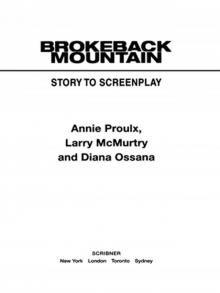 Brokeback Mountain
Brokeback Mountain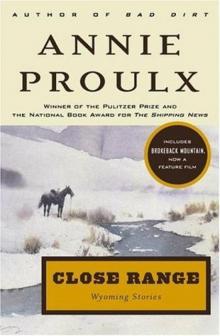 Close Range
Close Range That Old Ace in the Hole
That Old Ace in the Hole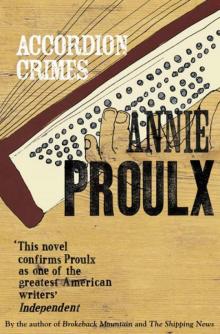 Accordion Crimes
Accordion Crimes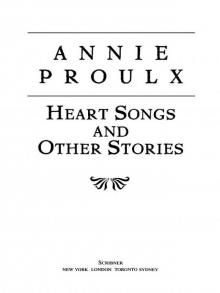 Heart Songs and Other Stories
Heart Songs and Other Stories The Shipping News
The Shipping News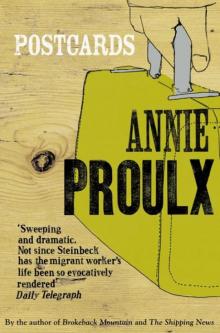 Postcards
Postcards Bird Cloud
Bird Cloud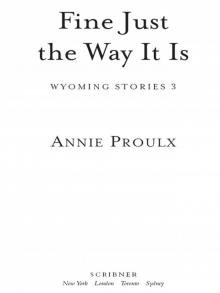 Fine Just the Way It Is
Fine Just the Way It Is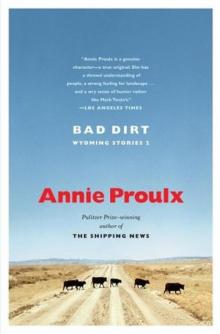 Bad Dirt
Bad Dirt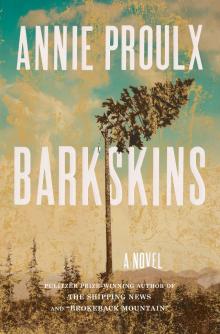 Barkskins
Barkskins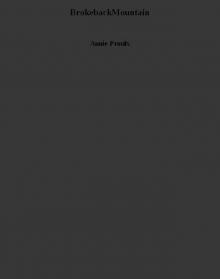 BrokebackMountain
BrokebackMountain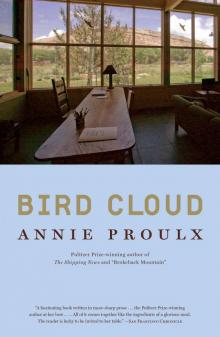 Bird Cloud: A Memoir of Place
Bird Cloud: A Memoir of Place Shipping News_A Novel
Shipping News_A Novel